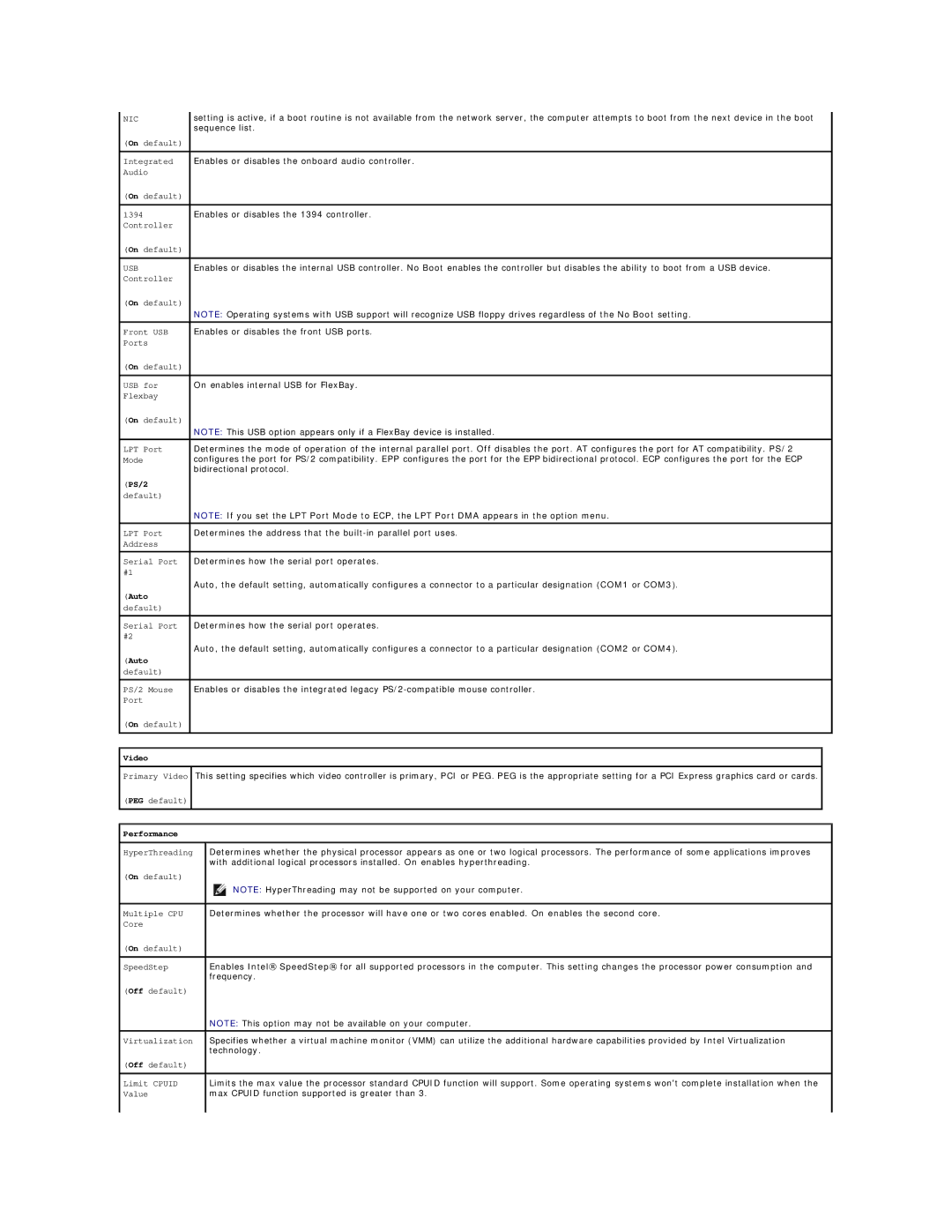NIC | setting is active, if a boot routine is not available from the network server, the computer attempts to boot from the next device in the boot | ||
| sequence list. | ||
(On default) |
|
|
|
|
|
|
|
Integrated | Enables or disables the onboard audio controller. | ||
Audio |
|
|
|
(On default) |
|
|
|
|
|
|
|
1394 | Enables or disables the 1394 controller. | ||
Controller |
|
|
|
(On default) |
|
|
|
|
|
|
|
USB | Enables or disables the internal USB controller. No Boot enables the controller but disables the ability to boot from a USB device. | ||
Controller |
|
|
|
(On default) |
|
|
|
| NOTE: Operating systems with USB support will recognize USB floppy drives regardless of the No Boot setting. | ||
Front USB | Enables or disables the front USB ports. | ||
Ports |
|
|
|
(On default) |
|
|
|
|
|
|
|
USB for | On enables internal USB for FlexBay. | ||
Flexbay |
|
|
|
(On default) |
|
|
|
| NOTE: This USB option appears only if a FlexBay device is installed. | ||
|
|
|
|
LPT Port | Determines the mode of operation of the internal parallel port. Off disables the port. AT configures the port for AT compatibility. PS/2 | ||
Mode | configures the port for PS/2 compatibility. EPP configures the port for the EPP bidirectional protocol. ECP configures the port for the ECP | ||
| bidirectional protocol. | ||
(PS/2 |
|
|
|
default) |
|
|
|
| NOTE: If you set the LPT Port Mode to ECP, the LPT Port DMA appears in the option menu. | ||
|
|
|
|
LPT Port | Determines the address that the | ||
Address |
|
|
|
|
|
|
|
Serial Port | Determines how the serial port operates. | ||
#1 |
|
|
|
| Auto, the default setting, automatically configures a connector to a particular designation (COM1 or COM3). | ||
(Auto |
|
|
|
default) |
|
|
|
|
|
|
|
Serial Port | Determines how the serial port operates. | ||
#2 |
|
|
|
| Auto, the default setting, automatically configures a connector to a particular designation (COM2 or COM4). | ||
(Auto |
|
|
|
default) |
|
|
|
|
|
|
|
PS/2 Mouse | Enables or disables the integrated legacy | ||
Port |
|
|
|
(On default) |
|
|
|
|
|
|
|
|
|
|
|
Video |
|
|
|
|
|
|
|
Primary Video | This setting specifies which video controller is primary, PCI or PEG. PEG is the appropriate setting for a PCI Express graphics card or cards. |
| |
(PEG default) |
|
|
|
|
|
|
|
|
|
|
|
Performance |
|
|
|
|
|
| |
HyperThreading |
| Determines whether the physical processor appears as one or two logical processors. The performance of some applications improves | |
|
| with additional logical processors installed. On enables hyperthreading. | |
(On default) |
|
|
|
|
| NOTE: HyperThreading may not be supported on your computer. | |
|
|
| |
Multiple CPU |
| Determines whether the processor will have one or two cores enabled. On enables the second core. | |
Core |
|
|
|
(On default) |
|
|
|
|
|
| |
SpeedStep |
| Enables Intel® SpeedStep® for all supported processors in the computer. This setting changes the processor power consumption and | |
|
| frequency. | |
(Off default) |
|
|
|
|
| NOTE: This option may not be available on your computer. | |
|
|
| |
Virtualization |
| Specifies whether a virtual machine monitor (VMM) can utilize the additional hardware capabilities provided by Intel Virtualization | |
|
| technology. | |
(Off default) |
|
|
|
|
|
| |
Limit CPUID |
| Limits the max value the processor standard CPUID function will support. Some operating systems won't complete installation when the | |
Value |
| max CPUID function supported is greater than 3. | |
|
|
|
|
